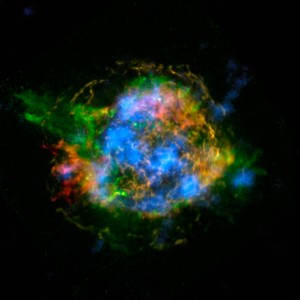Feb 20 2014
A new and powerful satellite has given researchers a way to see into the dark interiors of supernovae. Their observations of the supernova remnant Cassiopeia A shed more light on the mechanics of these explosions.
 Supernova Cassiopeia A. Image courtesy of NASA.
Supernova Cassiopeia A. Image courtesy of NASA.
“The new Cas A images give us new information about not only the elements that are created in a supernova, but the structure of these giant explosions,” says Stephen Reynolds, North Carolina State University astrophysicist, member of a team of scientists helping interpret data collected by the NuSTAR satellite and co-author of a paper describing the research. “These data will help us refine our models of these explosions to be more consistent with what actually happens when a star explodes.”
Much of what astrophysicists have observed from supernovae comes from X-ray imaging of the materials produced in the explosion. However, instruments usually cannot detect these materials unless they are hot. This poses a problem, as the material from the explosion cools rapidly as it expands. The cool material therefore becomes mostly invisible – at least until it catches up and slams into material ahead of it that has already been forced to slow down by surrounding matter, like a chain-reaction freeway collision. This collision, called a “reverse shock wave,” heats the material around the expanding edge of the supernova, rendering it visible again.
Researchers from the California Institute of Technology developed NuSTAR (Nuclear Spectroscopic Telescope ARray), the first X-ray satellite capable of making true images of more energetic, or “harder” X-rays, including those produced by radioactive titanium. Unlike the X-rays described above, which show material that is hot, radioactive titanium glows in X-rays no matter what, making it visible wherever it is. In a paper published today in Nature Communications, CalTech and Berkeley researchers detail their findings from Cas A.
Cas A is a supernova remnant located about 10,000 light years away from earth. It is a Type IIb supernova, meaning that the original star was a red giant about 20 to 25 times the weight of our sun that collapsed after losing most of its hydrogen envelope. Cas A went supernova around 1680 (as observed from Earth), making it the second youngest supernova known in our galaxy – so young that the radioactive titanium formed in the deep interior of the supernova is still decaying and producing X-rays.
Previous X-ray readings from Cas A showed a jet of silicon emanating from one side of the blast. Scientists believed that this deforming jet of material pointed to major asymmetry in the supernova’s structure. The more detailed NuSTAR images, however, revealed that this silicon jet was actually just a small deformation. The distribution of radioactive titanium in the interior of Cas A pointed to a more moderately asymmetric structure. This finding in turn confirms a model of supernovae where the matter does not all collapse perfectly inward, but “sloshes” around in a more disorganized way. However, the finding also creates a new puzzle. Theorists believed that titanium and iron are created close to one another in supernovae, but the images produced by NuSTAR show that this is not the case, suggesting that we still have much to learn about these explosions.
NuSTAR is a Small Explorer mission led by the California Institute of Technology in Pasadena and managed by NASA’s Jet Propulsion Laboratory, also in Pasadena, for NASA’s Science Mission Directorate in Washington. The research was funded by NASA. F.A. Harrrison, from CalTech, is the primary investigator. Co-investigators from CalTech include B.W Grefenstette, K.K. Madsen, K. Forster, P.H. Mao, H. Miyasaka and V. Rana. Berkeley co-investigator S.E. Boggs also contributed to the work.